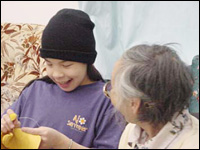


(photo from Holman, courtesy of Jeri Miltenberger, Fort Smith)
Aboriginal language loss is increasing at a rapid rate. The NWT has eleven official languages—nine of these are Aboriginal: Gwich'in, Inuktitut, Inuvialuktun, Inuinnaqtun, North Slavey, South Slavey, Dogrib, Chipewyan and Cree. The health of these languages varies greatly, but unfortunately most are declining.
Language is connected to culture and one's roots and identity. Elders tell us that it is important to speak your Aboriginal language because “languages are tied to knowing who you are in the core of your soul.” (First Nations Congress 1991) Footnote 3 Culture and language are important parts of who we are. Culture shapes the way we look at the world. Language represents culture, and shows which cultural group we belong to. We use language to pass on our culture from one generation to the next. Through language, we learn about the culture and traditions of our ancestors; and we learn our stories.
For many years, Aboriginal parents and educators were told that education in an Aboriginal language, whether through immersion or bilingual education, would be harmful to the children's education. Basically, they were told that if they taught their children their Aboriginal language at home it would ‘hold them back' in school. The result of this was that Aboriginal parents were told to teach their children English at home so they could get their children off to a good start in school.
Return to note 3 Source: Handbook for Aboriginal Language Program Planning in British Columbia, First Nations Education Steering Committee, Vancouver by Marianne B. Ignace Phd Secwepemc Cultural Education Society, Simon Fraser University